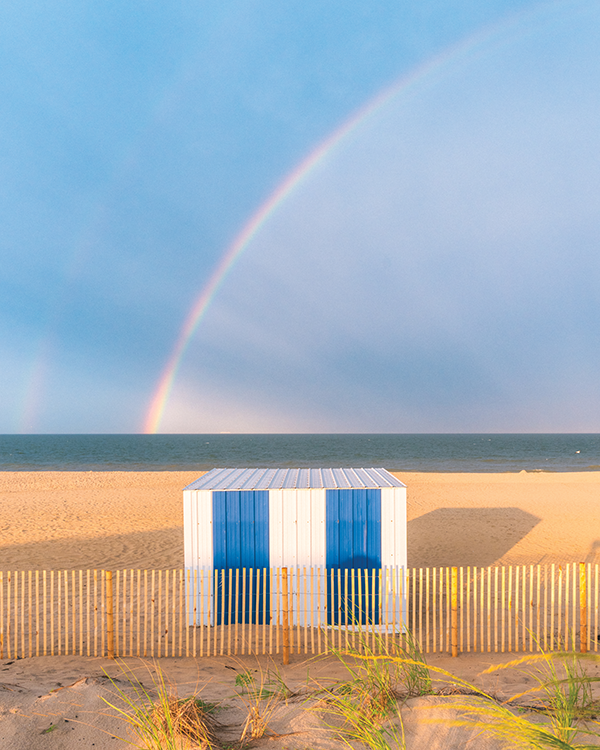Coastal photographer Elliot MacGuire shares what it takes to excel behind the lens
Written by Alex Csedrik
When Elliot MacGuire started his photography journey more than six years ago, it was emblematic of him embracing the slower pace of living in a beach town. “The coast is constantly changing with the seasons, and there is always something different or new to see,” MacGuire, a resident of Dewey Beach, says. It was appreciating the area’s daily changes he set out to document, and photography was the perfect medium for him. “Waking up to a new sunrise every day over the ocean, it’s hard not to be inspired.”
Throughout his career, he hasn’t only captured beach sunrises. He focuses on landscape, wildlife and real estate photography, as well as drone, real estate and wedding videography.

CAMERA COMPANIONS
Photographer Elliot MacGuire traditionally starts his work day before sunrise—and does so with his buddy, Shiloh, by his side.
One of the most interesting projects he did, however, was an undertaking very much a product of the times—he spent one year at the tail-end of Covid traveling the country, documenting his trip with stunning images. If this adventure sounds like it would be lonely, fear not, because he was joined by Shiloh, his faithful four-legged friend, a labrador mix.
While hanging out with your furry best friend and seeing the splendor of this great country may sound like fun and games, there is more to this medium than just clicking a button. “Photography involves hours of planning and preparation, and early mornings and late nights to get the shot you want,” Elliot says. “You’ll be reminded of all that work when you look back at every one of your photos.”
One of the most interesting projects he did, however, was an undertaking very much a product of the times—he spent one year at the tail-end of Covid traveling the country, documenting his trip with stunning images. If this adventure sounds like it would be lonely, fear not, because he was joined by Shiloh, his faithful four-legged friend, a labrador mix.
While hanging out with your furry best friend and seeing the splendor of this great country may sound like fun and games, there is more to this medium than just clicking a button. “Photography involves hours of planning and preparation, and early mornings and late nights to get the shot you want,” Elliot says. “You’ll be reminded of all that work when you look back at every one of your photos.”


MacGuire is cognizant of how scary it can be to start out. Therefore, he’s less concerned about what equipment amateurs use—which can create a barrier into the artform—and more interested in your intent. “Anyone who wants to start out in photography should just do it,” Elliot suggests. “Smartphone cameras are incredible these days, and you always have it with you. Plenty of times, I’ve used a lack of equipment as an excuse for why I couldn’t capture a specific shot when I could have, but the steps to capturing it would have looked very different.”
BEING PRESENT IN THE MOMENT
Elliot has learned from experience that photographers who are not focused on what’s in front of them can miss amazing opportunities.
No matter what, though, MacGuire maintains a Zen approach to both his life and art. “Capturing a moment requires us to be present,” Elliot adds. “Your camera and accessories help you freeze that instant in time, but they can also distract you from what you’re trying to capture. If a photographer isn’t focused on what’s in front of them, they’ll miss the shot every time.”
He continues to focus on what’s in front of him—the area’s daily changes—while documenting it all through his work.

Focal Points
Elliot’s recommendations for what’s most important to the art of photography

Do: Find a camera that forces you to think outside the box. I use a Fuji X 100V, a fixed lens camera, and it taught me to move physically rather than zooming in and out. This constraint unexpectedly freed my creativity, allowing me to focus more on the scene and less on the equipment.
Don’t: Feel you need to have an arsenal of gear. When I first started, I had not one, but three different drones—each with unique perspectives and capabilities. Unfortunately, this led to decision fatigue, and my art went from a joy to a chore.
Do: Focus on finding solutions. Your gear doesn’t prevent you from creating. If you’re fully immersed in the moment—and not preoccupied with the tools in your hands—your true creativity will come through.
Don’t: Go broke trying to acquire equipment because it makes you seem more professional. Work with what you have and push those boundaries.
You can do this by focusing on textures, experimenting with angles or stepping out of your comfort zone with different subjects. Then, you can reinvest in your career and upgrade equipment when you have more resources.
